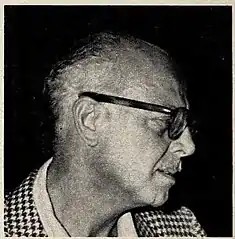Mitchell Leisen | |
|---|---|
 | |
| Born | James Mitchell Leisen October 6, 1898 Menominee, Michigan, U.S. |
| Died | October 28, 1972 (aged 74) Woodland Hills, California, U.S. |
| Occupation(s) | Director, Art Director, Costume Designer, Producer |
| Years active | 1920–1967 |
| Spouse | Sandra Gahle |
James Mitchell Leisen (October 6, 1898 – October 28, 1972) was an American director, art director, and costume designer.
Film career
He entered the film industry in the 1920s, beginning in the art and costume departments. He directed his first film in 1933 with Cradle Song and became known for his keen sense of aesthetics in the glossy Hollywood melodramas and screwball comedies he turned out.
His best known films include Alberto Casella's adaptation of Death Takes a Holiday and Murder at the Vanities, a musical mystery story (both 1934), as well as Midnight (1939) and Hold Back the Dawn (1941), both scripted by Billy Wilder. Easy Living (1937), written by Preston Sturges and starring Jean Arthur, was another hit for the director, who also directed Remember the Night (1940), the last film written by Sturges before he started directing his scripts as well.
Lady in the Dark (1944), To Each His Own (1946), and No Man of Her Own (1950) were later successes. Charles Brackett's comedy The Mating Season (1951) starring Gene Tierney, Miriam Hopkins and Thelma Ritter was an updated version of Leisen's earlier screwball comedies of the 1930s, and was also his last big movie success.
When his film career ended, Leisen directed episodes of such television series as Thriller, Shirley Temple's Storybook, The Twilight Zone, and The Girl from U.N.C.L.E.. He later became a nightclub owner.[1]
Personal life
Though married, Leisen was reported to be gay or bisexual. According to Carolyn Roos, Leisen's longtime business manager's daughter, he had a very long relationship with dancer/actor/choreographer Billy Daniel until the 1950s (Daniel died in 1962).[2][3] Leisen, with Daniel and dancer/actor Mary Parker, formed Hollywood Presents Inc. as a means of promoting both Daniel and Parker off-screen.[4] Leisen died of heart disease in 1972, aged 74. His grave is located in Chapel of the Pines Crematory.[5]
Awards
He garnered his sole Academy Award nomination in 1930 for Art Direction for Cecil B. DeMille's Dynamite.[6] He directed Hold Back the Dawn (1941), which was nominated for the Academy Award for Best Picture.
Filmography (as director)
References
- ↑ "Mitchell Leisen - Overview". allmovie.com.
- ↑ Barrios, Richard (2005). Screened Out: Playing Gay in Hollywood From Edison To Stonewall. Routledge. p. 157. ISBN 0-415-92328-X.
- ↑ Mitchell Leisen at the TCM Movie Database
- ↑ "Leisen's Circus". Look Magazine. August 1941.
- ↑ Wilson, Scott. Resting Places: The Burial Sites of More Than 14,000 Famous Persons, 3d ed.: 2 (Kindle Location 27393). McFarland & Company, Inc., Publishers. Kindle Edition.
- ↑ "NY Times: Dynamite". Movies & TV Dept. The New York Times. 2012. Archived from the original on October 17, 2012. Retrieved December 7, 2008.
Further reading
- Chierichetti, David (1995). Mitchell Leisen: Hollywood Director. Photoventures. ISBN 978-0-929330-04-4. Revised version of a 1973 biography.
- Kehr, Dave (May 13, 2008). "New DVDs: Mitchell Leisen and 'The Big Trail'". The New York Times.
The very model of the crack studio director, Mitchell Leisen spent much of his career at Paramount, where he tackled projects as radically different as the archly theatrical "Death Takes a Holiday" (1934) and the frothy revue film "The Big Broadcast of 1938" with the same composure and elegance.
Kehr's review of the DVD releases of Easy Living (1937) and Midnight (1939). - Melville, David (2006). "Mitchell Leisen". Senses of Cinema (37). Melville is one of several critics who have been reassessing Leisen's contributions to cinema; he writes, "Leisen, glimpsed in this new light, is no longer a swishy hack. He's a subtle and stylish auteur who could add heart and humanity to the brittle sophistication of Billy Wilder, lend grace and elegance to the boisterous Americana of Preston Sturges. In his Biographical Dictionary of Film, David Thomson hails Leisen as "an expert at witty romantic comedies, too reliant on feeling to be screwball, too pleased with glamour to be satires – and thus less likely to attract critical attention.""
- Rappaport, Mark (2008). "Mitchell Leisen". Rouge. This essay was written as an introduction to a retrospective series of showings of Leisen's films in 2008 at the Cinémathèque Française, which is in Paris, France. As does Melville, Rappaport speculates on how some of Billy Wilder's and Preston Sturges' scripts that Leisen directed would have fared if their writers had directed them instead.
- Shadoian, Jack (September 1, 1998). "Exacting standards: Director Mitchell Leisen's film "To Each His Own" epitomizes the director's work". Film Comment. 34 (5): 40. Retrieved February 3, 2011.
Seeing Leisen's films, though, kindles the urge to get up in arms, hoist a banner or two in the hope of securing the director his rightful share of the limelight. Segue to To Each His Own, a quintessential Leisen weepie – what one could unkindly call glittery trash created by the best minds of the motion picture industry, but that just might be wonder-full enough to do the job.
Shadoian is a film scholar who wrote the monograph Dreams and Dead Ends: The American Gangster Film (1978, 2003).